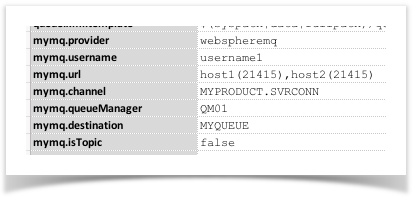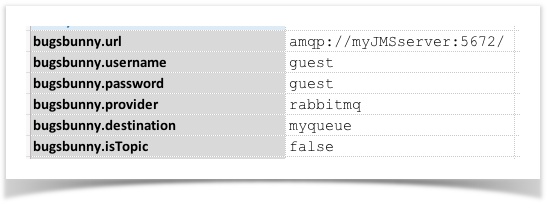jms
JMS standards Java Messaging Service. It is an essential feature in the Java Enterprise Edition specification (since v1.4). You can get more introductory content about JMS here, here and here.
With regards to JMS, Nexial’s aim is not to implement every single JMS capability. From test automation standpoint, the bulk of the message interaction evolves around “send message” and “receive message”. These 2 operations are currently supported in Nexial. Based on needs and demand, we might possibly implement other JMS operations, such as DELETE.
Connection Configuration
Similar to other commands that interact with remote system, the JMS commands require a “configuration” object to
specify the connectivity and security credential. These set of configurations are “bundled” together under a name,
such as MyServer. Below is a table to outline such configurations:
| configuration name | value | explanation |
|---|---|---|
MyServer.provider
|
Possible values:
|
[REQUIRED] More options could be added on as-needed basis. Raise an issue if your JMS vendor is not on this list. For <codewebspheremq</code> (WebSphere MQ), additional jar files are required to be added to the ${NEXIAL_HOME}/lib directory. Visit
here to learn more about
the required WebSphere MQ client jar files.
|
MyServer.url
|
e.g.:
|
[REQUIRED] The URL or URI specific to the target Message server. This is usually vendor specific (except for JNDI-based JMS server). Check product documentation or IT support for details. For RabbitMQ, the url starts with amqp:// or amqps://. Note that the
virtual host (aka virtual context) is specified as the part of the url. For a virtual host of
/, end the url with /.For WebSphereMQ, the url consists of a list of listeners in the form of host(port).
For example, server1(port1),server2(port2).For ActiveMQ, the url starts with tcp:// or tcps://.For JNDI-based JMS server, the url would be the standard JNDI url - jnp://host:port/.
|
MyServer.username
|
the username to access the target JMS server |
[REQUIRED] if required by JMS server and provider is not jndiConsider using nexial-crypt to protect sensitive information.
|
MyServer.password
|
the password to access the target JMS server |
[REQUIRED] if required by JMS server and provider is not jndi Consider using nexial-crypt to protect sensitive information.
|
MyServer.destination
|
either topic or queue name |
[REQUIRED] use isTopicto determine if this destination is a queue or a topic.
|
MyServer.isTopic
|
true or false
|
specify as true if your destination is a Topic. Default is false.
|
MyServer.initialContextFactory
|
For JNDI-based JMS access only. [REQUIRED] if provider is jndiSpecifying the initial context factory to use. The value of the property should be the fully qualified class name of the factory class that will create an initial context. This would be synonymous to " java.naming.factory.initial".
|
|
MyServer.connectionFactory
|
For JNDI-based JMS access only. [REQUIRED] if provider is jndiSpecify the JNDI name of the object that provides connection to the target JMS server. Consult vendor documentation or IT Support for details. |
|
MyServer.jndiUsername
|
For JNDI-based JMS access only. [REQUIRED] if provider is jndiSpecify the username to access the target JNDI server. This would be synonymous to " java.naming.security.principal".
|
|
MyServer.jndiPassword
|
For JNDI-based JMS access only. [REQUIRED] if provider is jndiSpecify the password to access the target JNDI server. This would be synonymous to " java.naming.security.credentials".
|
|
MyServer.channel
|
For WebSphereMQ access only. [REQUIRED] if provider is webspheremqThe channel name by which the intended JMS connections and operations will be connected. Check vendor documentation or IT Support for details. |
|
MyServer.queueManager
|
For WebSphereMQ access only. [REQUIRED] if provider is webspheremqThe name of the queue manager from which the message operations will be issued. Check vendor documentation or IT Support for details. |
Examples
- WebSphereMQ

- ActiveMQ

- RabbitMQ
